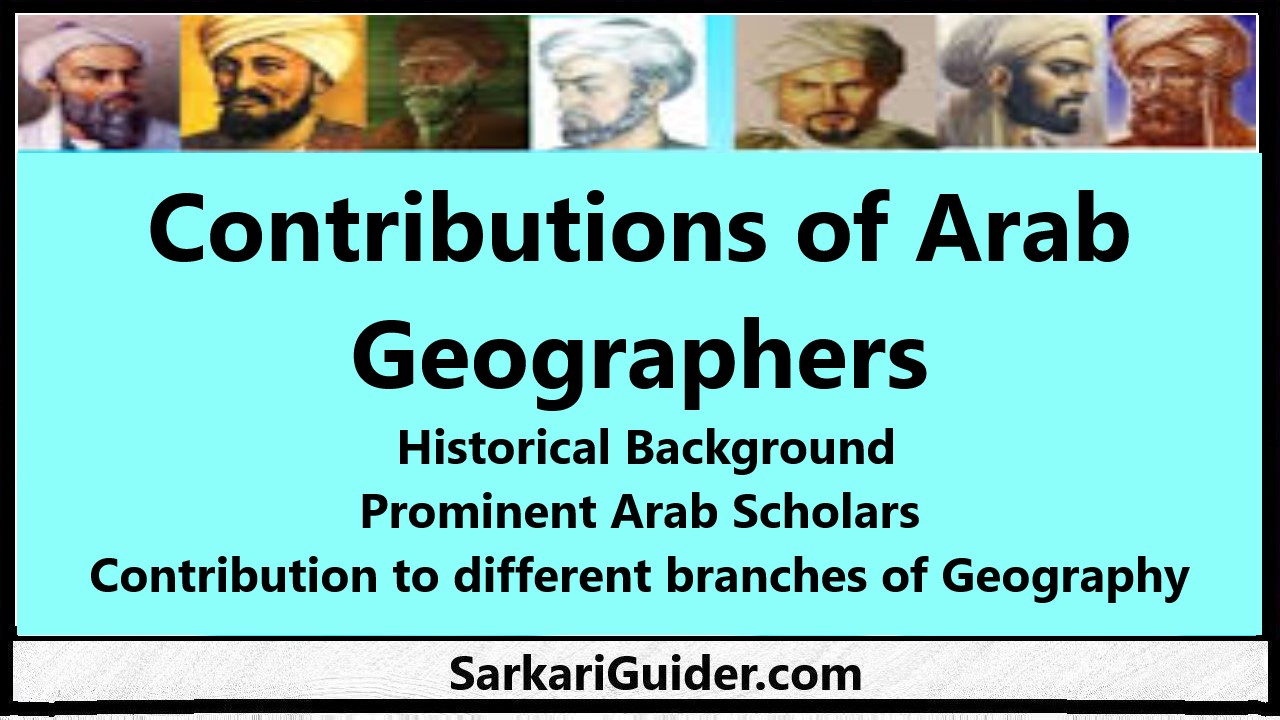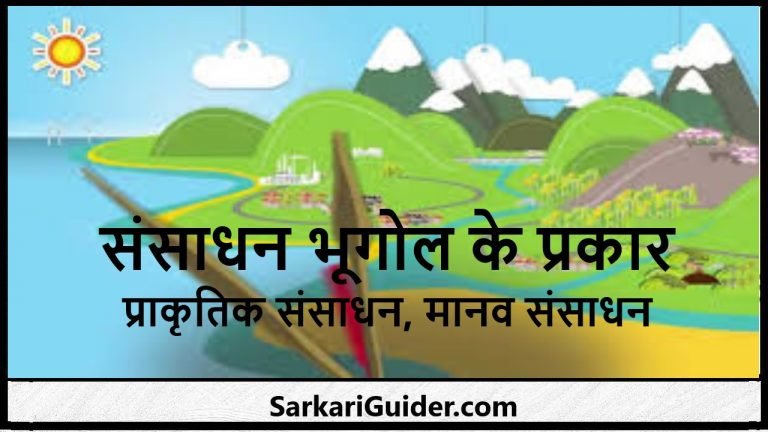Contributions of Arab Geographers – Historical Background, Prominent Arab Scholars, Contribution to different branches of Geography

Contributions of Arab Geographers – Historical Background, Prominent Arab Scholars, Contribution to different branches of Geography
-
Introduction
Contributions of Arab Geographers – Muslim geographers in the medieval period made valuable contributions to the geographical thinking unlike their Western counterparts. They are remembered for the concepts, paradigms and theories which still are of vital importance even in present times. The base their knowledge was much wider and enriched than the Christian scholars. Their interest in geography was the product of their geographical surroundings; though it was purely theological in perspective. The rise and spread of Islam from 7th to 14th century further widened their horizons as Muslims started travelling across the world either for religious or economic reasons.
In the field of geography the Muslim scholars have made significant contributions in the fields of mathematical, physical, and regional geography. Their knowledge was based on the information gathered on the works of Greeks and other oriental civilizations. Through these observations and analytical reasoning they made noteworthy interpretations on different phenomenon occurring over the surface of the earth especially in the fields of climatology, geomorphology, cartography (determination of cardinal points) and so on. Muslim geography flourished in the city of Baghdad and it became a centre of learning for more than a century.
-
Historical Background
Most of the Muslim geographers like Al- Maqadisi (945-1000 AD) followed the scientific method while compiling their works. There were three main sources of information, namely, the relevant available literature, personal observations made during their own travel and the information gathered from reliable persons about the lands for which the other two methods were not enough. They were passionate for travelling which is evident from the fact that they believed in collecting information themselves. Examples may be cited of Al-Idrisi’s (1100-1166 AD) travels in south, north and west Europe, Ibn Hauqal’s (943-969 AD) journeys to eastern part of Europe, Al-Biruni’s (973-1050 AD) travels in India, and finally Ibn Battuta’s (13041368 AD) travels which covered faraway places like India and China along with the entire Muslim World. Ibn Battuta’s travels in Africa took him as far south as Timbuktu on the river Niger (Schoy 1924; Ahmed 1947; Al-Shargawi 1968; Khasbakh 1971; Kish 1978; Al-Feel 1979; Al-Naggar and Al-Difa’a 1988).
One of the most important characteristic of Muslim scholars was that they brought comprehensiveness within the geographical thinking. The idea of specialization was not there as most of the writings are related to both physical and human geography; they also include facts on history, religion, philosophy, customs, dress and diets. The works of only two Arab geographers can be described as being highly specialized, namely, Al-Dinawari’s (d. 805 AD) work on climatology, and AlAsma’ai’s (d. 739?) book on plant geography. The Muslim geographic thought that evolved during the Middle Ages can be viewed from two perspectives. In the first case the contributions in geography were highly influenced by the works and writings of oriental civilizations namely Persians, Indians and Greeks. The second perspective holds more importance as here the purpose was not only to correct the wrong concepts passed down from previous civilizations but also make their own innovative contributions. Apart from making wonderful advancements in the field of astronomy and mathematical geography, Muslim geographers even investigated new branches of geography like urban, religious and linguistic geography.
-
Prominent Arab Scholars
The Muslim scholars in the middle ages made remarkable contribution to the geographical scholarship. Their contribution is of such an importance that some of the theories and concepts given by them still hold an important place in the philosophy of geography. As already stated that the scholars of the Muslim world had more wider and enriched horizons the information thus provided was more realistic in nature; this becomes more important as during middles ages the Christian world was undergoing one of its darkest period and where no new substantial advancement was made. Some of the major contributions of the Muslim scholars have been discussed here.
These scholars have made remarkable observations in the field of physical geography especially climatology. To start with, reference can be made of Al-Balkhi who collected climatic data from the accounts of various Arab travelers and prepared the world’s first climatic atlas based on that data entitles Kitab-Al Ashkal in 921.
Al-Masudi was another important scholar who hailed from Bagdad. He was a geographer, a historian a world traveler and a prolific writer .He wrote on diverse themes and his important works include Mehraj-al-Duhab, Kitabul Aswat, KitabAkhbar-Zaman. Al-Masudi described the weather conditions of the places he visited or sailed through ad also pointed out that the salt in the seas comes from the land. I the field of study of landforms he appreciated the role of process of erosion and adjustment of streams to structure in the evolution of landforms. He had a clear idea of the spherical shape of the earth. In the field of human geography he tried to study the relationship between human beings and the environment and explained the impact of environment on the mode life and attitude of people (environmental determinism). He even divided the world into seven regions on the basis of language.
Al-Biruni was a Tajik by race and a Persian by culture; his main interests include astronomy, mathematics, chronology, physics, medicine and history. He was a prolific writer; books include Kitab-al-Hind, Al-Qanuan-Almasudi and Tarikul Hind. Kitab-al-Hind (1030) is regarded as his monumental work which deals with the geography of India. He describes the processes shaping the landforms under normal conditions and even identifies the significance of rounded stones in the alluvial deposits in the southern part of the Himalayas. He mentioned that the distribution of rainfall in the peninsular region is controlled by the eastern and western Ghats. He provided detailed information about the source of Indus and explained the phenomena of floods in its basin. He gave the description of the city of Qannauj. He has provided an accurate account of the seasons of India describing the nature of monsoons. He had also studied Indian culture and Hindu beliefs.
In his astronomical writings he discussed and approved the earth’s theory of rotation on its axis and correctly calculated the latitudes and longitudes of many places. He provided his views on the origin of universe in his book Al-Tahidi. He explained the phenomena of solar and lunar eclipses .He also attempt to measure the longest and the shortest distance of the moon and the sun from the earth. He studied the relationship of tides with the phases of moon. In geomorphology he compared the fossils discovered in the plans of Arabia, Jurjan and Khwarizmi along the Caspian Sea and suggested the occurrence of sea at these places in the earlier times. One of the most interesting observations made by him is that “at the south pole the night ceases to exist” (Adhikari, 2010).
Another scholar who is credited to have made significant contribution to geomorphology is Ibn-Sina. He gave the idea of landscape erosion when he observed that the streams cut down their valleys when flowing down the mountains.
He further states that these streams worn down the mountains in a slow but steady process. He even examined the presence of fossils in the rocks in higher mountains.
Al idrisi was a leading scholar of the 12th century. His most important and famous book was Amusements for Him Who Desire to Travel Around the World (1154). His world map is considered as his most important contribution to geography. His map was based on a rough rectangular projection. He had studied Ptolemy’s work. His description of Sicily is perhaps the most detailed one and it is of great historical importance. Al Idrisi travelled over a great part of world including Spain, France, England, Sicily, Morocco, Asia Minor and interior parts of Africa. He described the course of many rivers including the Danube and Niger with precision. He did not agree with the Greek’s classification of the world into five climatic divisions and provided a more sophisticated classification based on climate.
Ibn Batuta was the greatest Muslim traveler of his time. He spent 28 years in travel and crossed a distance of more than 75000 miles. His primary interest was in people though he has described the physical conditions of various regions that he visited. His description of house types and building materials in deserts is very interesting and informative. Through his experience he labels Morocco as the best of the countries. His book Rihlah provides an insight into the soils, agriculture, economy and political history of the then Muslim world. He came to Delhi on an invitation of Mohd. Tughlak and served as a Qazi of Delhi.
Ibn Khaldun was basically a historian but his writings also have been important as they were based on travel. His most important work is known as Muqaddimah. In his writings, Ibn Khaldun has maintained that the northern hemisphere is more densely populated than the southern. He stated that the population along the equator is sparse, but there is an increasing concentration away from it up to 60 degrees. Further away there is little or no population. He emphasized the role of fertile land in the origin of settlements. He has argued that the origin of the large cities have always been in the form of small settlements. Ibn Khaldun is considered as one of the early environmental determinists as he tried to correlate man and his environment in a scientific way. He is also credited of establishing political geography in the middle period where he discusses the rise and fall of dynasties and empires. He formulated the first concept of life-cycle of the state. In the words of Kimble (1938) “Khaldun may be considered to have discovered the true scope and nature of geographical enquiry but the fact remains that his knowledge of the physical earth is based largely on Greek theory; and his ideas about environment influence are not highly sophisticated.”
The period from the fifth and fifteenth centuries was remarkable as several concepts and theories were firmly established. There were improvements in the art of navigation which set the next step for the discovery of the world.
-
Contribution to different branches of Geography
On the whole, it may be said at the outset that Muslim geographers paid less attention to the physical aspects of geography as compared to the human ones. Nevertheless, there was reference to landforms, oceanography, climatology and biogeography (James and Martin 1981). Here we will discuss their contributions to the various fields or sub-branches of geography.
a) MATHEMATICAL GEOGRAPHY
The Arab scholars were highly influenced by the Greek ideas about the shape and size of the earth. They considered the Earth as the centre of the universe, around which the seven planets revolved. They made use of the Ptolemy’s prime meridian to calculate time and longitudes. This meridian was considered to pass through the Fortunate Islands, Abu Mashar. These scholars made use of the shadow of the sun to determine latitudes; when the shadow happens to be on the meridian. Al Battam is said to have measured the earth’s circumference as 27,000 miles.
b) PHYSICAL GEOGRAPHY
In physical geography they have made significant contributions to climatology, geomorphology, oceanography and bio-geography. Each one of these are discussed here.
i. Climatology:
The first climatic atlas is credited to Al-Balakhi who gathered climatic data and information from Arab travellers and prepared the first climatic atlas of the world— Kitab-ul-Ashkal (921). One of them divided the world into 14 climatic regions. His name is Al-Maqdisi who also presented the idea that the southern hemisphere was mostly an open ocean and most of the world’s land area was in the northern hemisphere. The doctrine of environmental determinism found roots in the writings of Ibn-Khaldun, Al-Beruni and Al-Masudi who described the influence of climatic conditions on the lifestyle of the people. Ibn-Khaldun further opined that people residing in the wormer parts of the earth were more passionate. He related the dark skin colour of the Negros with the location of their habitat in the warmer region. AlMasudi described Indian monsoons and even elaborated the factors like location, height above the sea level, setting of a place with accordance to mountains or sea and soil type all play a decisive role in the weather and climate of a particular area. Geographers like as Al-Istakhri, Ibn Khordadbeh, and Al-Maqadisi divided world into different climatic regions using the temperature and rainfall indices.
ii. Geomorphology:
Al-Beruni in his Kitab-ul-Hind opined that the stones became round because they had fallen along torrential mountain streams. He also discovered that alluvial soils became finer in texture farther away from mountains. Ibn SIna keenly observed the works of agents of denudation and ascertained that mountain streams erode the slope; the highest peaks occur when the rocks are especially resistant to erosion; the mountains are immediately exposed to the process of wearing down as soon as they rise up. Al-Maqadisi (945-1000 AD) in his book: “The Best Divisions for the Classification of Regions” divided Syria into four geomorphological zones running parallel to the Mediterranean Sea as follows:
- a sand plain running close to the sea.
- a mountainous area with vegetation cover and settlements
- an area of lowlands and depressions with deep river valleys (part of the rift valley) having settlements.
- an area of cold high mountains where bedouins lived.
Al-Masoudi (895-957 AD) refers to the changing relationship between land and sea. He even talks with reference to a ‘geographical cycle’ and categorically identifies three stages of rivers – youth, maturity and old-age. He further establishes his point by stating that these three stages are similar to those found even in the lives of plants and animals.
iii. Oceanography:
The most outstanding contribution in the field of oceanography was that the Arab scholars proved that the main reason for tides was the gravitational pull of the sun and the moon. This observation was done by Al-Qazwini. Al-Masudi noted that due to the presence of vegetation and salinity the colour of the ocean water varies from place to place.
iv. Biogeography:
Abu Zeid Al-Ansary (732-825 AD), Abu Said Al-Asma’ai (740-828 AD), Ikhwan AlSafa’, and Al-Qazwini. Al-Asma’ai are some of the noteworthy Arab scholars who contributed i the field of plant and animal geography. Al-Qazwini even made an attempt to classify and distribute the natural vegetation of the Arabian Peninsula.
c) HUMAN GEOGRAPHY:
The branch of Human geography interested Arab geographers, and they made contributions to almost all the sub-branches of human geography, that is, cultural, urban, medical, economic and so on.
i. Cultural Geography
Ibn Khaldün divided the population of the world into two categories – nomadic and sedentary; and argued that nomadic life preceded sedentary life of human beings. Scholars like Al-Maqadisi and Al-Istakhri wrote how physical characteristics of man especially their physique, colour of the skin, temperament, and costumes differs from region to region. Al-Maqadisi along with Al-Hamadani even made reference of the fact that in Arabia people spoke different dialects. Ibn Khaldün in his book relates that as the Arabs started travelling they blended with the non-Arab communities which resulted in the distortion of their language – Arabic. Some scholars also studied the distribution of other languages in other regions especially Persia.
ii. Urban Geography
In the field of urban geography these scholars diverted their attention to the studies of urban settlements. They related the concepts of site and situation and even tried to classify towns and cities on the basis of their size. Al-Khwarizmi in his book ‘Surat Al-Ard’ or ‘Description of the Earth’ (d. 850 AD) fixed the coordinates for nearly 539 towns. In another monumental work, Al-Bakri (1040-1094 AD) came up with a geographic dictionary of place names where he notes down approximately 5200 sites. Some Muslim scholars like Al- Qazwini (1208-1283 AD) and Ibn Khaldün (1332-1406 AD) wrote on the relationship thaty existed between environmental conditions and health in realtion to the establishment of new settlements. These scholars also directed their attention on the morphology of urban settlements especially with regard to the internal structure of the towns. The functions of these settlements have also been dealt with. Al-Maqadisi even identified an hierarchical order in his discussion on the settlement system; this was with respect to the size of the settlements. He stated that very large urban centres or capital cities were like Kings while the regional centres were like ministers. He also provided detailed writings on the cities of Makkah, Taif and Jerusalem. One of the works that needs special mention in this field is the model proposed by AlQazwini (1208-1283 AD) for the city of Qazwin in Persia.
iii. Economic Geography
Ibn Khaldün made an attempt of defining trade; he stated that it is the act of making profit by buying goods at low prices and selling them at higher prices. Writings also covered famous marketing centres at the local, regional and international levels. Writers gave accounts of the goods that entered into commercial transactions and the routes used for their delivery. There was also reference to the currencies, and the measures and weights in use (Muhammadain 1981, 1984)
iv. Medical Geography
Another branch in which the Arab and Muslim geographers of the Middle Ages made valuable contribution is the medical geography. Large part of their writings is related to the study of diseases and their occurrence in various regions. Many of them believed that there exists a positive relationship between disease and climate Yaqüt Al-Hamawi (1179-1229 AD) stated those practicing medicine should have sufficient knowledge about their geography as well. Al-Maqadisi noted that the inhabitants of Baghdad had a low rate of life expectancy. The name of Al-Nuwairy (1287-1342 AD) needs to be mentioned as he identified the places that were known for poisonous animals like snakes and scorpions and also such places where carriers and vectors of disease such as rats, mice, fleas, ticks and flies were found in large numbers. The contribution of these scholars in the pharmacological studies cannot be ignored, they wrote extensively on the extraction of medications from herbs and plants. (Muhammadain 1981, 1984; Al-Naggar and Al Difa’a 1988).
-
Conclusions
The above account clearly shows that the Arab and Muslim geographers had contributed in a considerable way to geographical scholarship. The Muslims had more advanced culture than did most of medieval Europe, and had made great discoveries in various fields of study (Hasan 1967). They preserved many of the writings of ancient Greek, Roman and other oriental civilizations and made use of them to enrich their knowledge. To sum up one can say that the contributions of Arab and Muslim
geographers gave a better understanding to the geographical thought and broadened its horizon as number of sub-branches like regional, mathematical geography and surveying developed. Most of the works of the scholars of the Middle Ages were comprehensive in nature as they covered almost all aspects of both physical and human geography.
महत्वपूर्ण लिंक
- भारतीय संविधान की विशेषताएँ
- जेट प्रवाह (Jet Streams)
- चट्टानों के प्रकार
- भारतीय जलवायु की प्रमुख विशेषताएँ (SALIENT FEATURES)
- राजा राममोहन राय की सम्पूर्ण जीवन यात्रा
- मृदा नमी को प्रभावित करने वाले कारक
- भूमिगत जल को प्रभावित करने वाले कारक
- परमाणु रिएक्टर का निर्माता एनरिको फर्मी
- भूमिगत जल के स्रोत
- वाष्पोत्सर्जन को प्रभावित करने वाले कारक
- मृदा नमी संरक्षण
- Important aspects related to the life of Netaji Subhash Chandra Bose
- Swami Dayanand Saraswati’s important contribution in social reform
- राजीव गांधी के व्यक्तित्व से जुड़े रोचक तथ्य
- Indian Citizenship
- अभिभावक शिक्षक संघ (PTA meeting in hindi)
- कम्प्यूटर का इतिहास (History of Computer)
- कम्प्यूटर की पीढ़ियाँ (Generations of Computer)
- कम्प्यूटर्स के प्रकार (Types of Computers )
- अमेरिका की क्रांति
- माया सभ्यता
- हरित क्रान्ति क्या है?
- हरित क्रान्ति की उपलब्धियां एवं विशेषताएं
- हरित क्रांति के दोष अथवा समस्याएं
- द्वितीय हरित क्रांति
- भारत की प्रमुख भाषाएँ और भाषा प्रदेश
- वनों के लाभ (Advantages of Forests)
- श्वेत क्रान्ति (White Revolution)
- ऊर्जा संकट
- प्रमुख गवर्नर जनरल एवं वायसराय के कार्यकाल की घटनाएँ
- INTRODUCTION TO COMMERCIAL ORGANISATIONS
- Parasitic Protozoa and Human Disease
- गतिक संतुलन संकल्पना Dynamic Equilibrium concept
- भूमण्डलीय ऊष्मन( Global Warming)|भूमंडलीय ऊष्मन द्वारा उत्पन्न समस्याएँ|भूमंडलीय ऊष्मन के कारक
- भूमंडलीकरण (वैश्वीकरण)
- मानव अधिवास तंत्र
- इंग्लॅण्ड की क्रांति
- प्राचीन भारतीय राजनीति की प्रमुख विशेषताएँ
- प्रथम अध्याय – प्रस्तावना
- द्वितीय अध्याय – प्रयागराज की भौगोलिक तथा सामाजिक स्थित
- तृतीय अध्याय – प्रयागराज के सांस्कृतिक विकास का कुम्भ मेल से संबंध
- चतुर्थ अध्याय – कुम्भ की ऐतिहासिक एवं सांस्कृतिक पृष्ठभूमि
- पंचम अध्याय – गंगा नदी का पर्यावरणीय प्रवाह और कुम्भ मेले के बीच का सम्बंध
Disclaimer: sarkariguider.com केवल शिक्षा के उद्देश्य और शिक्षा क्षेत्र के लिए बनाई गयी है | हम सिर्फ Internet पर पहले से उपलब्ध Link और Material provide करते है| यदि किसी भी तरह यह कानून का उल्लंघन करता है या कोई समस्या है तो Please हमे Mail करे- sarkariguider@gmail.com





